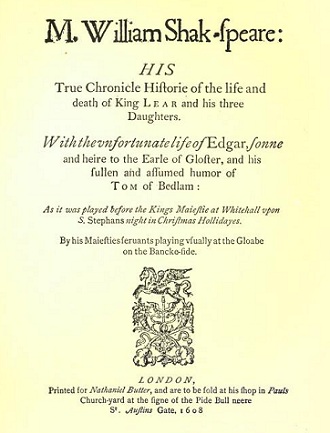| directory |
| home | contact |
|
|||||||||||||||
| search | |||||||||||||||
The Chronology of Shakespeare's PlaysEstablishing the chronology of Shakespeare's plays is a most frustrating and difficult task. It is impossible to know the exact order of succession because there is no record of the first production date of any of Shakespeare's works. However, scholars have decided upon a specific play chronology, based upon the following sources of information: 1) several historical events and allusions to those events in the plays; 2) the records of performances of the plays -- taken from such places as Henslowe's diary and the diaries of other Shakespeare contemporaries like John Manningham (a student at the Inns of Court), and Thomas Platter (a Swiss businessman); 3) the publication dates of sources; 4) the dates that the plays appear in print (remembering that the production of a play immediately followed the completion of that play in the Elizabethan age). Despite the fact that we have an accepted play chronology, we must keep in mind that the dating is conjectural.Please click on each play to find extensive study resources and fascinating details. Please see The Historical Settings of Shakespeare's Plays (by Date) for a chronology of the content of the plays. *The Two Noble Kinsmen is listed as one of Shakespeare's plays although it must be noted that all but a few scholars believe it not to be an original work by Shakespeare. The majority of the play was probably written by John Fletcher, who was a prominent actor and Shakespeare's close friend. Fletcher succeeded Shakespeare as foremost dramatist for the King's Men (the successor to the Chamberlain's Men). How to cite this article:____ Related Articles |
 Bard Bites Dramatist and Shakespearean scholar Nicholas Rowe was the first to write a critical (annotated) edition of Shakespeare's works. ___ The average length of a play in Elizabethan England was 3000 lines. With 4,042 lines and 29,551 words, Hamlet is the longest Shakespearean play (based on the first edition of The Riverside Shakespeare (1974)). With 1,787 lines and 14,369 words, The Comedy of Errors is the shortest Shakespearean play (also based on the first edition of The Riverside Shakespeare). ___ Shakespeare's late comedies are considered romances: The Winter's Tale, The Tempest, Cymbeline, and Pericles. The Two Noble Kinsman is also sometimes mentioned along side these other plays as a romantic comedy. ___ Love's Labour's Lost has the highest percentage of rhyming lines of all of Shakespeare's plays. According to Shakespearean scholar Tucker Brooke, 62.2% of the lines in Love's Labour's Lost rhyme. The closest competitor is A Midsummer Night's Dream, with 43.4% rhyming lines. ___ The historical time of King Lear is roughly 800 BC, making it the second-earliest setting of any of Shakespeare's plays. Click here to find out the first. |
©1999-2021 Shakespeare Online. All Rights Reserved.